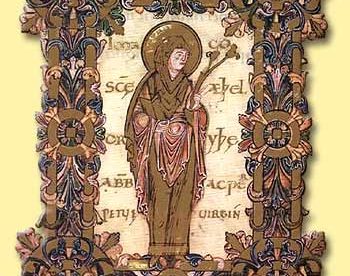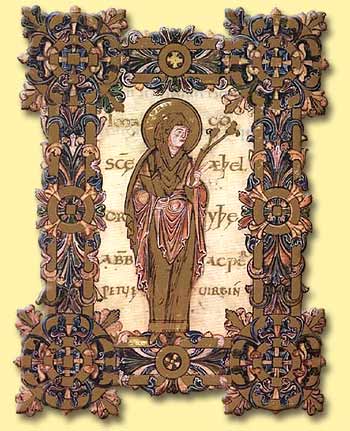Why Things are Tawdry

The word “tawdry” is an adjective which means “gaudy” or “showy and cheap,” and typically modifies apparel. But it’s not a typical word — it’s only one of two English words ending in -wdry, and the other word, “blowdry,” is a compound word. “Tawdry” is a word that really shouldn’t exist, but, well, it does.
To find out where it comes from, we need to travel back to the Kingdom of Northumbria — and yes, that is a real place, or was once. If it sounds like something out of an Arthurian legend, that’s because Northumbria existed from the year 653 until 954, and makes up what is now northern England and southeastern Scotland. (Here’s a map.) Along the way, Northumbria had many rulers, but of particular note — for our purposes at least — is Æthelthryth, who was briefly its queen.

Æthelthryth — or “Audrey,” the modern-day equivalent for those of us who don’t know how to pronounce things in Old English — wasn’t in power for very long. Legend has it that Audrey wished to remain a virgin throughout her life; despite being married twice, she somehow succeeded in this goal. To accomplish this, she fled from her second husband (her first died, leaving her a widow) and founded an abbey in the English city of Ely.
Her life as a nun was uneventful. The last notable fact about her life came to pass toward the end; ultimately, she ended up with a large, unsightly growth on her neck. As Catholic Online’s biography of Audrey states, she “gratefully accepted [the likely tumor] as Divine retribution for all the necklaces she had worn in her early years.” The growth is blamed for costing Audrey her life; she died on June 23, 679. But her commitment to her faith did not go unnoticed by the Church. She was later canonized as St. Audrey, the patron saint of throat complaints. And, like many other saints, she’d later be celebrated by future generations.
Those celebrations took place on in Ely on the day of her feast, June 23rd (or October 17th per some sources). Those feasts attracted travelers which, in turn, attracted merchants. Many merchants began selling lightweight necklaces made of lace, perhaps as an homage to St. Audrey’s affliction. Regardless, if you visited Ely on her feast day, you probably had the chance to buy some St. Audrey’s Lace, as these necklaces became known. And you could also buy a bunch of other knick-knacks which commemorate the day and the woman being honored.
Over time, these tchotchkes became less and less well-made; that is, they became showy and cheap. And the St. Audrey’s lace was no exception. But something about the necklaces did change — their name. As word master Merriam-Webster notes, “by the 17th century [St. Audrey’s lace] had become altered to tawdry lace,” with the “t” from “Saint” running into the “Audrey.” Later, M-W continues, “tawdry came to be used to describe anything cheap and gaudy that might be found at these fairs or anywhere else.”
So next time you use the word “tawdry,” remember — you’re invoking the name of the Catholic saint of throat complaints.
Bonus fact: A sore throat is what ultimately did in George Washington . . . kind of. On December 14, 1799, Washington woke up in the middle of the night with what was likely epiglottitis, a severe throat infection. Whether he would have survived without treatment is hard to say, but in this case, the medicine was likely worse than the disease. Washington was a firm believer in bloodletting as a remedy and asked his doctors to do just that. But the physicians removed a lot more blood than they should have — Wikipedia puts it at “half or more of his total blood content” over the course of a few hours — and Washington died that evening.
From the Archives: Why We Have a Silent B: The kind of silly reason “doubt” and “debt” have a “b” before their “t”s.
